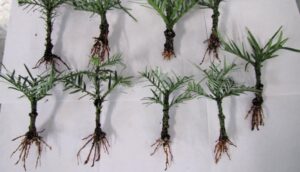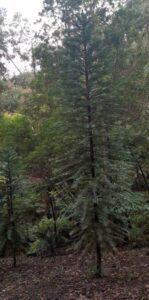Propagation to save the Wollemi Pine
By Matt Coulter
Wollemia nobilis is listed by the IUCN (International Union for the Conservation of Nature) as a critically endangered tree species. The species is commonly known as Wollemi Pine and is, in fact, not a pine but a member of a 200-million-year-old plant family, the Araucariaceae, predominately a southern hemisphere plant family that includes Araucaria, Agathis, and the monotypic genus Wollemia.
The species was known from fossil records and was thought to have gone extinct up to two million years ago. In 1994, a National Parks Ranger with the NPWS NSW, David Noble, was abseiling in the Wollemi National Park in a deep remote rugged canyon 150 kilometres Northeast of Sydney and came across these unusual, tall coniferous trees that were very different from anything that he had seen before.
Wollemia nobilis dates to the Jurassic and Cretaceous periods around 200 million years ago, hence it is sometimes known as the dinosaur tree. It is thought that there are fewer than 100 mature plants in the wild population. It has been described as one of the most significant botanical finds in 100 years, and conservation of the species is an incredibly important procedure for botanic gardens around the world.

The Botanic Gardens and State Herbarium of South Australia (BGSH) have been involved in the ex-situ conservation of Wollemia nobilis since the year 2000, when they received two plants that were germinated from the wild populations that Royal Botanic Gardens Sydney (RBGS) had grown on and distributed.
One tree was planted at the Adelaide Botanic Garden and one at the Mount Lofty Botanic Garden, as the two gardens exhibit quite different climate parameters, including temperatures and rainfall. The two original trees, still growing in the original sites, were initially caged, as was instructed until the commercial propagation of the species could be undertaken. Around 2005, commercially propagated plants were distributed in Australia and around the world, and the cages were removed.
BGSH evaluated the growth and performances of the two plants across the two sites and found that plants growing within the Mt Lofty Botanic Garden performed better than the Adelaide Botanic Garden and this site would be the preferred location for more plantings. Furthermore, it was found that specific micro-climates within the Mt Lofty Botanic Garden site were an important parameter to identify. The area known as Fern Gully is a dark moist gully growing fern collections and other shade-loving plants and was found to be an ideal area for Wollemi pines to thrive. There are 29 living trees recorded on the BG-BASE botanical database with their own accession details.

Initially, new plants were either purchased or donated to BGSH to be planted within Fern Gully at Mt Lofty Botanic Garden, but later it was decided to propagate known provenance plants instead of purchasing material of unknown provenance. The nursery staff of BGSH decided to initiate a trial to understand if plants could be propagated from the original two trees from RBG Sydney, of which extensive data on the provenance was known.
Propagation material was sourced from the original tree planted at Mt Lofty Botanic Garden and careful consideration was undertaken to select shoots coming away from the main trunk that showed an apical dominant bud. Cuttings were prepared and set out with standard operating procedures developed by the nursery, where stem cuttings were cut into 10-15cm cuttings, lower leaves removed, and the cut made just below a node.
The cut end was dipped into a commercially formulated IBA gel formulation at 3000ppm, and the cuttings were then planted into a community pot of propagation material (80% perlite / 20% coir peat) and placed into a humidity tent where at least 75% humidity was retained utilising ultrasonic fog and intermittent misting, and placed onto bottom heat beds set at 25ºC.
The cuttings remained in the propagation humidity area until roots had formed and were first checked about 8 weeks after planting the cuttings. Individual rooted plants were potted into 100mm standard pots using a premium potting mix. The material that was used was variable in quality, however, excellent results were achieved and a success rate of 90% or better was reached with this method, and once potted on, the quality of the trees produced was high.
Many of the plants that were propagated have been planted and are now growing at Mt Lofty Botanic Garden. The plants were grown in root pruning and root training pots so when they were planted, they had a good, extensive root system which helped in their development. Later trials were undertaken to show cuttings could successfully be rooted from horizontal branches; however, the shoots did not grow vertically but instead grew horizontally, which is not a desirable trait for the tree.
More trials have been carried out utilising propagation material from the original tree from the Adelaide Botanic Garden using the apical dominant shoot method as described above. The main difference was to evaluate this material against the horizontal shoot method. The horizontal cutting method produces a plant with undesirable attributes to be planted out, however, these plants are kept in the nursery as teaching examples for trainees and staff.
Subsequent propagation trials have shown similar results, where cuttings with good quality apical dominant shoots successfully make adventitious roots on cuttings, and when carrying out good nursery practices, high-quality planting material can be achieved.
Some recent work has been undertaken by RBG Sydney where individuals of wild populations have shown to have genetic variability. These trees have been identified and plants have been propagated and sent to botanic gardens around the world.
BGSH of SA have six new plants in our nursery waiting to be planted in autumn 2024. These plants are very important, and over the next six months staff will be evaluating sites where they can be planted out. These individuals have a lot of data documented about them, which will be recorded on BG-BASE and their subsequent performance and growth will be evaluated.

